SHAOLIN KUNGFU REVIEW COURSE - OVERVIEW
28th and 29th December 2008
Sungai Petani, Malaysia
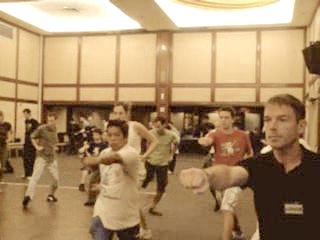
Course participants are having a great time at the review course
This Shaolin Kungfu Review Course was held on 28th and 29th December 2008 in Sungai Petani, Malaysia as part of Sifu Wong Chun Nga's wedding celebrations.
Cultivation of Jing, Chi and Shen, or the Physical, Energy and Mind
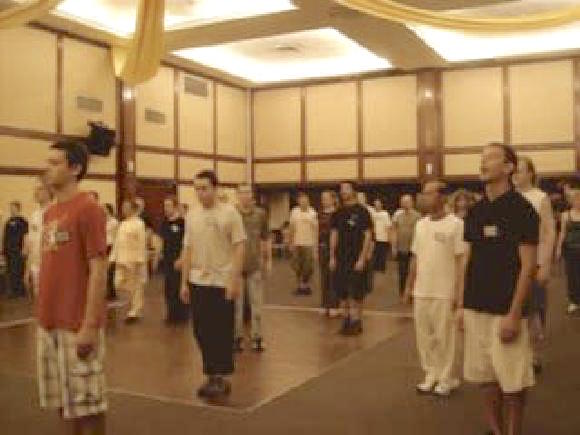
Generating an energy flow, entering Zen and practicing the Horse-Riding Stance are three of the most important and most advanced aspects of Shaolin Kungfu training, and they are review right at the start.
They also represent the three dimensions of kungfu training, namely jing, qi and shen, or the physical, energy and mind.
Click here to enter.
Some Finer Points Regarding the Bow-Arrow and the Horse-Riding Stance
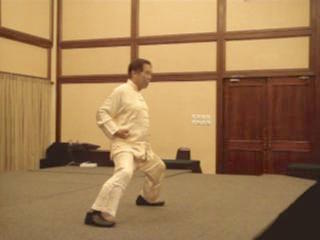
Grandmaster Wong reviews the finer points of the Bow-Arrow and Horse-Riding Stance. Important questions like differentiating yin-yang, rotating the waist and why we perform the Bow-Arrow Stance with feet in line and toes hooked inward, are answered.
Do you know why we can develop so much internal force by practicing the Horse-Riding Stance? You can get the answer from the videos too.
Click here to enter.
How to Move Correctly and Speedily in Stances
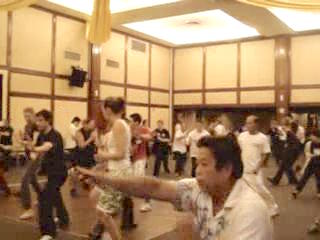
Nowadays many kungfu practitioners have discarded their stances, thinking erroneously that the stances are a hindrance to their fast movements.
Grandmaster Wong first shows how to move correctly in stances, then how to substantially increase the speed of moving in stances.
Click here to enter.
The Mechanics of Exploding Force

"Fa-jing" or exploding force is an important aspect of kungfu training. Two conditions are needed for exploding force. Firstly, the exponent must have sufficient internal force to be exploded. Secondly, he must know the mechanics involved.
The pattern "Black Tiger Steals Heart" is utilized to learn the skill of exploding force. The movement starts from the back leg, is controlled by the rotation of the waist, and is completed at the punch, manifesting the three external harmonies of legs, body and hands. The punch spirals forward, channeling internal force from the dan tian.
Click here to enter.
Exploding Force with Various Patterns
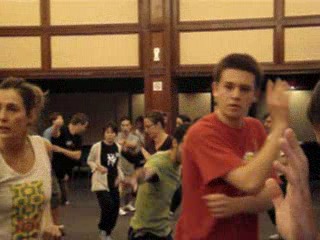
Once you have the skill of exploding force using "Black Tiger Steals Heart", you can use it in other patterns. The principles are the same. The movement starts from the back leg, is controlled by the waist, and the force is exploded in the hand. Course participants use the skill to explode force in "White Snake Shoots Venom", "Precious Duck Swims through Lotus" and "Hang a Golden Star at a Corner".
Click here to enter.
Linking Patterns to Form Combat Sequences
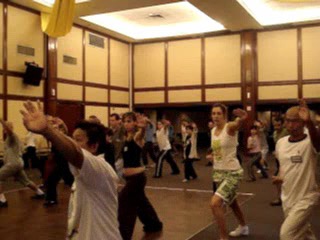
Various patterns are linked together in a meaningful way for combat, resulting in combat sequences. Four such combat sequences are formed and they are named after their signature patterns. Course participants practice the four combat sequences with explosion of force.
Click here to enter.
Pre-Arranged Sparring to Develop Combat Skills
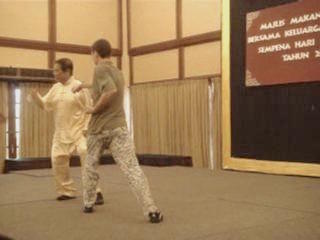
Combat Sequences 1 and 2 are used to practice pre-arranged sparring. The patterns are pre-arranged so that the practitioners can focus on combat skills. The skills specially emphasized at this beginning stage of training are right spacing, right timing and picure-perfect form.
Click here to enter.
Important Skills in Sequences 3 and 4
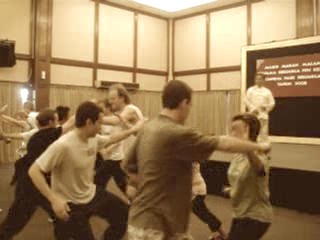
Here course participants practice Combat Sequences 3 and 4. Two important skills are introduced in Combat Sequence 3, namely footwork adjustment to attain right spacing, and adequate coverage to ensure safety first. The skills of continuous attack and flowing into an opponent are found in Combat Sequence 4.
Click here to enter.
Applying Continuation of Sequence in Sparring
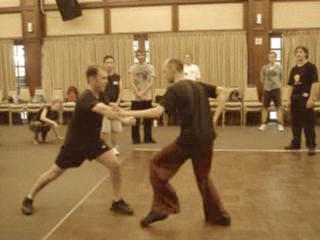
After pre-choice and self-choice, the next step in our sparring methodology is continuation. Here, the initiator or the responder continues to another combat sequence after completing the first combat sequence. Some footwork adjustment is needed.
More importantly, you must cover your opponent adequately as you continue to another sequence. In our revised terminology �“ the methodology is the same but we use different terms to describe the stages �“ this is addition, i.e. adding a new sequence.
Click here to enter.
Skillful Manipulation of Combat Sequences in Sparring
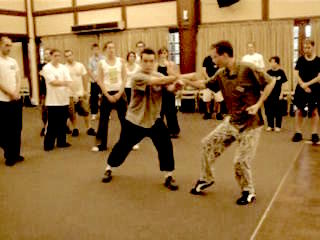
Combat sequences form the core of our sparring methodology. By a skillful manipulation of just the first four sequences, which deal with hand attacks, we can have a variety of strategies to attack our opponents.
We can also develop effective combat skills that enable us to respond correctly and spontaneously with good Shaolin techniques against an opponent’s hand attacks.
Click here to enter.
Combat Sequence 5 - Fierce Tiger Speeds through Valley
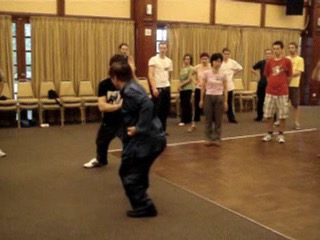
While Combat Sequences 1 to 4 focus on developing skills, Combat Sequences 5 to 8 widen the scope of techniques. Sequences 5 to 8 use mainly the right leg mode in attack, whereas in Sequence 1 to 4 it is mainly the left leg mode. The skillful application of the “thread hand” is introduced in pressing attacks.
Click here to enter.
Combat Sequence 6 - Dark Dragon Draws Water
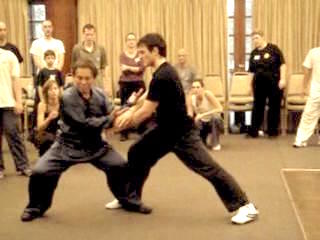
If you train "Dark Dragon Draws Water" fifty times a day everyday for six months, you may be so skillful that whenever an ordinary opponent attacks you with a right punch, you can break his ribs as soon as he attacks. The counter against the palm strike is profound. When an opponent attacks you with a powerful chop, whether you break his arm or have your own arm broken depends much on how you place your "Immortal Emerges from Cave".
Click here to enter.
Combat Sequence 7 - Chop the Hua Mountain
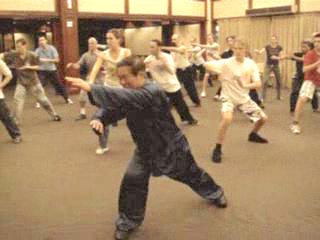
"Bar the Big Boss" is introduced here against an opponent’s attack instead of using "Single Tiger". In Combat Sequence 6, you execute a chopping attack after avoiding your opponent’s sweep on your low punch. Here in Combat Sequence 7, you execute a chopping attack after you sweep an opponent's low punch. A skillful application of "Double Bows Tame Tiger" often strikes an opponent before he realizes it.
Click here to enter.
Combat Sequence 8 - Horizontally Sweep a Thousand Armies

A number of sophisticated techniques are found in his short sequence. For example, you can break your opponent’s arm as soon as he attacks. Do you know that there are three such examples here? On the other hand, if an opponent attempts to break your arm as you attack, as in the third example of the hand sweep, you can apply the tactic of “leaking hand” to strike his head.
Click here to enter.
Enjoying Chi Flow and Sparring

Shaolin Kungfu is chi kung. After practicing combat sequences, course participants enjoy a vigorous chi flow. Some of the chi flow movements are quite interesting. More significantly they are very beneficial. After being recharged and refreshed from the chi flow, they continue to enjoy their sparring. It is heartening that everyone uses Shaolin patterns in their combat.
Click here to enter.
Overcoming Two Big Problems in Free Sparring and Real Fighting
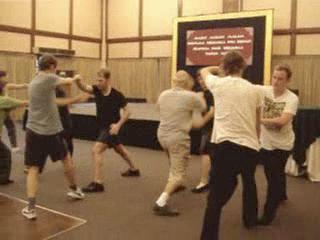
Kungfu exponents today all over the world face two big problems in free sparring or real fighting. One, they cannot effectively use their kungfu patterns to attack. Two, they cannot respond correctly and spontaneously with their kungfu patterns in defence. We are happy and proud to have overcome these two problems using our sparring methodology.
Click here to enter.
Using Modifications when Applying Combat Sequences
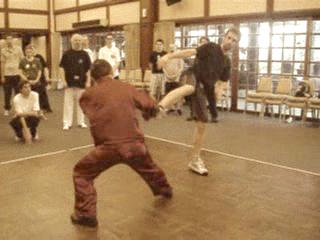
A common question many people ask is that as their opponents' attacks and defences are random, how could combat sequences which are fixed in routine be useful in sparring or fighting. Our students who have gone through our sparring methodology should have no problem realizing that this is an academic question. If they have followed our sparring methodology they would have found the answer from their direct experience.
Click here to enter.
Countering Surprised Kicks and Throws while Applying Combat Sequences
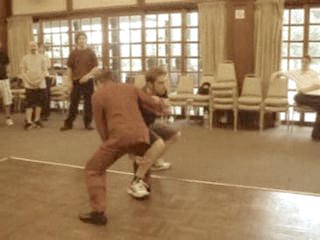
Grandmaster Wong explains how you can use modifications in combat sequences against an opponent who applies kicks or throws. If your opponent surprises you with a kick, for example, as you move in with your planned sequence, retreat stance and simultaneously strike his kicking leg. If he attempts to fell you, move your stance or change your step. Various throwing techniques are illustrated.
Click here to enter.
Combat Sequence 9 - Side-Body Tiger-Tail Kick
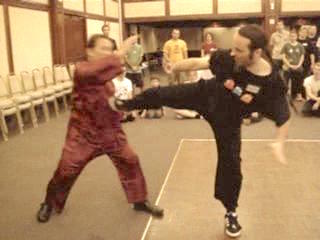
The Tiger-Tail Kick is a famous Shaolin technique. There are two main types of Tiger-Tail kicks, the straight-body Tiger-Tail Kick, which is more exclusive, and the side-body Tiger-Tail Kick, which is more common and often just called a side-kick because the exponent’s body is leaned to one side for a successful kick. A side-body Tiger-Tail Kick is found in our Shaolin Combat Sequence 9.
Click here to enter.
Combat Sequence 10 - Heart-Piercing Thrust Kick
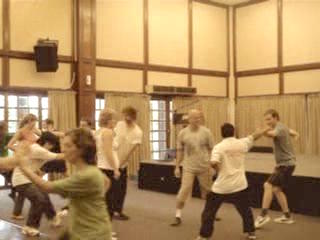
Our combat sequences are supportive of one another. If you lay a trap with Combat Sequence 9 to tempt your opponent to attack so that you can counter with a side-body Tiger-Tail Kick but he hesitates, you can spontaneously continue with Sequence 10 using a heart-piercing thrust kick. This sequence, with four attacks in a row, is excellent for implementing the tactic of pressing attack. You must, of course, ensure sufficient coverage as you press in to attack.
Click here to enter.
Intercepting and Countering Ferocious Pressing Attacks
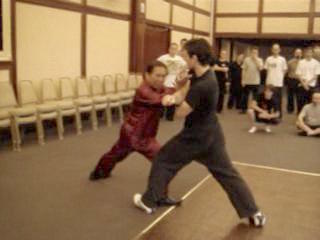
How do you stop an opponent pressing in with ferocious attacks? There are numerous ways. A poor response is to retreat, though it can be used as a trap. An excellent way to stop him is to intercept him with a Mirror Hand. Another excellent way is to use the Tiger-Claw. You can then counter-attack him. Footwork and body-movement are important to ensure a successful interception and counter.
Click here to enter.
The Important Skills of Coverage and Interception
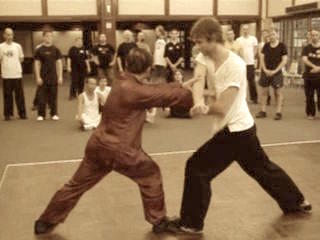
Coverage and interception are two very important skills needed to apply combat sequences successfully. Many kungfu practitioners lack these skills or an understanding of them, which often results in their being hit randomly and continuously. As you attack with your combat sequences, you must ensure adequate coverage for your own safety first. If an opponent attacks you relentlessly, you have to intercept him to counter-attack
Click here to enter.
Combat Sequence 11 - Deadly Organ-Seeking Kick
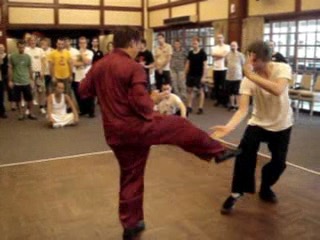
Some time ago when Grandmaster Wong mentioned that there were more kicks in Shaolin Kungfu than in all the well-known martial arts put together, some martial artists, without checking the facts, were angry. One of the common Shaolin kicks that are not commonly found in other martial arts, or at least not to such sophistication, is the deadly organ-seeking kick. It is the kick that can break through Iron Shirt and Golden Bell.
Click here to enter.
Combat Sequence 12 - Formidable Whirlwind Kick
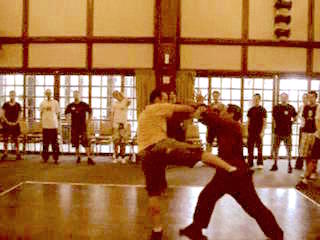
Many people are weary of the Muay Thai sweeping kick. Blocking the sweeping kick, as is often shown in martial art movies, is not a good defence; it may result in the blocking arm or hand being fractured. In Shaolin Kungfu this sweeping kick is known as a Whirlwind Kick. A good way to defend against a whirlwind kick is to intercept it. A "soft" counter is to avoid the whirlwind kick by leaning your body back without moving your legs.
Click here to enter.
Combat Sequence 13 - Fell Tree with Root
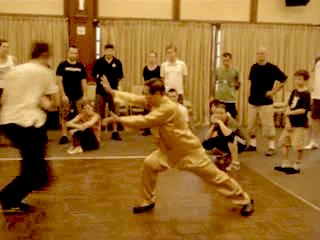
Many Shaolin students think mistakenly that there are little or no felling techniques in Shaolin Kungfu. Actually there are more Shaolin felling techniques than in any other martial arts. All the throws in Judo and Wrestling, for example, can be found in Shaolin. Combat Sequences 13 to16 deal with felling techniques. In this series, backward throws are used, and are executed with the Shaolin pattern “Fell Tree with Roots”. Its counter also demonstrates the sophistication of the Unicorn Step and Butterfly Palms.
Click here to enter.
Combat Sequence 14 - Lead Horse Back to Stable
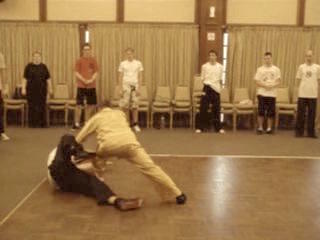
We can also fell an opponent using "Fell Tree with Roots" in our standard right leg mode if his left leg is in front, but we would have to get across to his back right leg. Similarly, we can fell an opponent using "Lead Horse Back to Stable" in our standard left leg mode if his right leg is in front, but we would have to make some slight modification depending on whether he is attacking with his right or left hand. This makes combat very interesting, though to other people it can be confusing.
Click here to enter.
Combat Sequences 15 and 16 - Hoe Field and Push Mountain
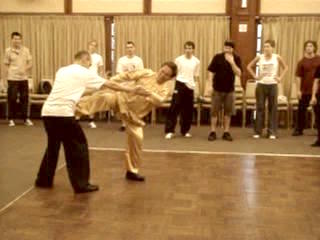
Right spacing is necessary for Combat Sequence 16, "Fierce Tiger Pushes Mountain". Your front leg must go in between his two legs as you push. Make sure you cover your opponent adequately so that he can not strike you. Pushing him away is being compassionate. You may strike him instead.
Click here to enter.
Many Effective Techniques against Boxers

There are many Shaolin techniques against Boxing. Here we give him a fighting chance and let him have some fun. We use techniques that a Boxer has counters in his repertoire. Two tactics are employed here, "Cover and Strike" and "Open and Strike". Notice that good stances and body movement give us great advantages. If we do not give Boxers a fight chance, we use techniques outside his repertoire, like kicks and felling techniques.
Click here to enter.
Changing a Boxer's Strength into his Weakness
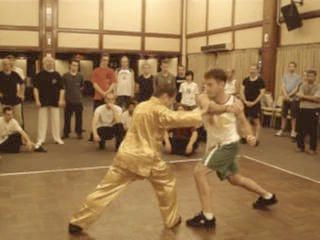
The bouncing about of a Boxer can be his strength or his weakness. To most martial artists, it is the Boxer’s strength - it makes him agile and fast. This is a main reason why many martial artists, not only kungfu practitioners, throw away their own techniques and bounce like a Boxer. But for us, if we know how to use our good points, we can make the Boxer’s strength his weakness. These videos show you how.
Notice that we make good use of our three external harmonies - footwork, body-movement and hand techniques. Our one step can cover the distance a Boxer needs two steps to bounce. With moving our feet, we can use body-movement to avoid or attack a Boxer who has to bounce forward or backward. We can cover a Boxer while attacking him, giving him no chance to counter-strike.
Click here to enter.
Felling Boxers and Kick-Boxers
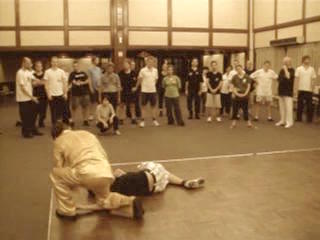
Many people find the undercut, known in Shaolin Kungfu as "Skyward Cannon Punch", formidable. It is actually quite easy to counter if if you know how. One effective counter is to employ "White Ape Breaks Branch" to dislocate his elbow or to fell him.
When you can handle a Boxer, handling a Kick-Boxer is not difficult. A good strategy is to fight him like a Boxer, but when he kicks, strike his kicking leg. You can also fell him when he withdraws his leg after kicking. It is easy to fell Boxers and Kick-Boxers if you have the skills and techniques because they have no counters in their repertoire to counter felling attacks.
Click here to enter.
Plant Willow to Counter Formidable Muay Tahi Knee Jabs
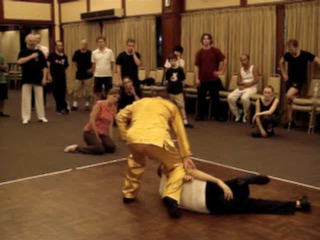
Fighting a Muay Thai fighter is not easy. It is not the same as fighting a Kick-Boxer. His sweeping kicks are generally faster and his elbow strikes more powerful. The typical Muay Thai knee strike is formidable, and many people do not know how to counter it. But we are very lucky - we have an excellent counter passed on to us from Sigung or Sitaigung Ho Fatt Nam, who himself was a Muay Thai champion before he gave it up for Shaolin Kungfu. The counter is "Plant Willow in Front of Camp". This video series also show the conclusion of this Review Course, where course participants have fun, chi flow and standing meditation.
Click here to enter.
LINKS
Shaolin Kungfu Review Course, 28th and 29th December 2008
- Cultivation of Jing, Chi and Shen, or the Physical, Energy and Mind
- Some Finer Points Regarding the Bow-Arrow and the Horse-Riding Stance
- How to Move Correctly and Speedily in Stances
- The Mechanics of Exploding Force
- Exploding Force with Various Patterns
- Linking Patterns to Form Combat Sequences
- Pre-Arranged Sparring to Develop Combat Skills
- Important Skills in Sequences 3 and 4
- Applying Continuation of Sequence in Sparring Practice
- Skillful Manipulation of Combat Sequences for Sparring
- Combat Sequence 5 Fierce Tiger Speeds through Valley
- Combat Sequence 6 Dark Dragons Draws Water
- Combat Sequence 7 Chop the Hua Mountain
- Combat Sequence 8 Horizontally Sweep a Thousand Armies
- Enjoying Chi Flow and Sparring
- Overcoming Two Big Problems in Free Sparring and Real Fighting
- Using Modifications when Applying Combat Sequences
- Countering Surprised Kicks and Throws while Applying Combat Sequences
- Combat Sequence 9 Side-Body Tiger-Tail Kick
- Combat Sequence 10 Heart-Piercing Thrust Kick
- Intercepting and Countering Ferocious Pressing Attacks
- The Important Skills of Coverage and Interception
- Combat Sequence 11 Deadly Organ-Seeking Kick
- Combat Sequence 12 Formidable Whirlwind Kick
- Combat Sequence 13 - Fell Tree with Root
- Combat Sequence 14 - Lead Horse Back to Stable
- Combat Sequences 15 and 16 - Hoe Field and Push Mountain
- Many Effective Techniques against Boxers
- Changing a Boxer's Strength into his Weakness
- Felling Boxers and Kick-Boxers
- Plant Willow to Counter Formidable Muay Thai Knee Jabs
